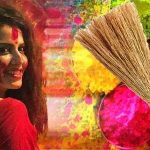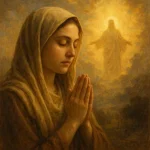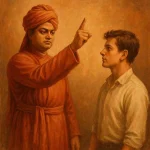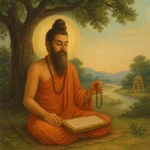In December with winter at its peak when most of us don’t even stir out of bed for a morning walk, Vaihanavites or the people who follow Krishna Sampradaya take bath in ice-cold water and rush to temples where ‘Tiruppavai’ is recited as it is the month of Margazhi or Dhanur. It is a big ritual in every South Indian household.
Most of the women cut short their hours of sleep and wake up as early as 4.00 a.m. and have the doorstep decorated with beautiful `kolams’. One could also witness pumpkin flowers sprouting out right at the centre of the `kolams’. But what is this special month, why does is it so significant for them? Let us find out-
According to the Mythology, the month of Margazhi or Dhanurmasam is said to be the morning time for the Devas, who pray to Sriman Narayana in this time (One day for Devas is One year for us). Sri Andal sung the 30 paasurams of Thirupaavai to attain Sriman Narayan during these 30 days and finally attained Sriman Narayana Himself. Lord Krishna Himself himself has said in Gita, “Among the months, I am Margazhi“. The Pagal Pathu & Raa Pathu utsavams, when the Thiruvaimozhi Pasurams are recited, happen in all Divyadesams during this month only. Srirangam Pagal Pathu & Raa pathu Utsavams are very famous. Vaikunta Ekadashi also occurs in this Auspicious month.
What is Margazhi or Dhanurmasam ?
As Sun transits through Dhanur Rashi (Sagarittus) it is called as Dhanur Maasa. Usually this maasa will be observed during Dec16, 17th to January 14, 15th. During this month, the sun transits the Dhanur Rasi until it enters the Makara Rashi during the end of this month on the Makara Sankranthi day.
Why is it considered as Shoonya maasa?
Dhanurmasam is also known as Chaapamaasa, KodanDa maasa, shoonya maasa. This full month is reserved for Srihari, he has to be wroshipped along with Lakshmi only. To enable pooja of Srihari, the auspicious functions has been restricted other functions and as Sun sets in Dhanur it is not good for any functions like upanayana, marriage, gruhapravesha. If we do these mangala kaaryaas, we will not get upanayana phala, punya of Kanyadhana in marriage. That is why we must not do any such functions in this month. – As this month is dedicated to gods only and for it is a blank month, it is termed as “shoonya maasa”
What is Vaishnava Sampradayam?
Vaishnavas are a sect in Brahmins who traditionally practice a lifestyle follow the doctrine of vaishnavism. Lord Vishnu is their God and they believe Him to be the superior Almighty of all Gods.

Importance of Dhanurmasam
During dhanurmasam, Andal or Goda Devi, one of the 12 vaishnava Alvars, worshipped God with true devotion and utter love and married Him on the culminating Bhogi festival day(the final day of dhanurmasam). Andal means one who ruled over God with her pure and innocent, untainted love towards Him. She wore the flower garlands to test them and then only offered to God. She worshipped God by composing 30 hymns on 30 days praising His glory in her Tamil language. It is a kind of bathing herself in God’s grace all those 30 days and winning his love and heart through marriage. So this month is considered as very auspicious by all vaishnavas for performing puja and worship to attain salvation from all worldly problems.
It is considered holy, for, it is the day in which the Lord comes out of the sanctum sanctorum and enters the `Vaikunta vaasal’ also known as `sorga vaasal’. People generally consider the `Vaikunta vaasal’ as the gateway to paradise.
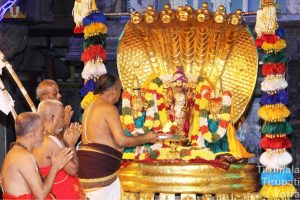
How is Dhanurmasam or Margazhi observed
Dhanurmasa m is to be performed all through the 30 days starting from the day sun entering the Dhanus rasi and ending on the day prior to sun entering Makara rasi. The day sun enters makar rashi is celebrated as Makar sankranti.
One should get up early in the morning and after bathing, wear pious clothes and cook the pongal for offering to God. Prior to that, the house and neighbourhood needs to be cleaned and a feeling of religious atmosphere is to be created for experiencing a better spiritual feeling and divine happiness. You may decorate your house with flower garlands and mango leaves, etc. House entrance needs to be taken more care of. The door entrance wooden frame bottom portion (threshold or doorway) can be decorated by applying turmeric paste and spots of kumkum or rori. Rangoli is done in front of the door entrance to bring a beautiful look to your house entrance. There is a tradition of placing Gobbillu in the rangoli throughout the month of dhanurmasam. It gives a religious and spiritual atmosphere to your house.

Legend of Andal
one of the best-loved poet-saints of the Tamils. Pious tradition sees her a veritable descent of `Bhumi Devi’ (Mother Earth) in `human form’ to show humanity the way to His lotus feet (Lord Rangamannar). She is present in all Vaishnavite temples, in India and elsewhere, next to her Lord, as she always desired.
Andal is better remembered for her hymns. Describing herself as a young girl, still not fully mature, she seeks the help of all including animals in her quest to attain Him. Finally, she describes her good fortune of being the daughter of Vishnuchitta (also known better as `Periyalvar), the best of the devout, who lived in Srivilliputtur, and adores the Lord. Her first work, `Tiruppavai’, is a poem of 30 verses in which Andal imagines herself a cowherd girl and yearns to serve Him to achieve happiness not only in this birth, but also in eternity, and describes the religious vow (pavai) that she and her fellow cowgirls will take for this purpose.
The impact of these works on the daily religious life of the south Indians could be witnessed in all Vaishnavite temples. Discourses on `Tiruppavai’ had become part and parcel of `Margazhi’.

Navedya’s in Dhanurmasam
Naivedya’s to the Lord are the most important feature in the pooja – the most popular being the pongal and We can offer Mudgnaanna (huggi), gojju (made of jiggery, tamarind), Butter to Srihari.
What are the prohibitions during the month?
Kshoura, mundane, Upanayana, marriage, gruhapravesha, etc
What are the different phalas for pooja during dhanurmasa?
We have to finish pooja when the stars are still twinkling. It is considered as the best. Pooja that finishes after the stars have vanished, but before sunrise, is considered as Medium, whereas pooja that completed after sunrise is inferior. Puja performed in the afternoon is practically useless. We have to do the pooja and naivedya atleast 96 minutes before sunrise.


